
About UsThe Numismatic Bibliomania Society is a non-profit organization promoting numismatic literature. For more information please see our web site at coinbooks.org SubscriptionsThose wishing to become new E-Sylum subscribers (or wishing to Unsubscribe) can go to the following web page link MembershipThere is a membership application available on the web site Membership Application To join, print the application and return it with your check to the address printed on the application. Membership is only $15 to addresses in the U.S., $20 for First Class mail, and $25 elsewhere. For those without web access, write to: David M. Sundman, Secretary/TreasurerNumismatic Bibliomania
Society AsylumFor Asylum mailing address changes and other membership questions, contact David at this email address: dsundman@LittletonCoin.com SubmissionsTo submit items for publication in The E-Sylum, just Reply to this message, or write to the Editor at this address: whomren@coinlibrary.com
BUY THE BOOK BEFORE THE COINYou won't regret it! |
- WAYNE'S WORDS: THE E-SYLUM JANUARY 11, 2009
- KOLBE JANUARY 10, 2009 NUMISMATIC LITERATURE SALES
- DAVID FANNING NUMISMATIC LITERATURE LAUNCHES "THE BOOKSHELF"
- NEW BOOK: TREASURE SHIP S.S. NEW YORK BY DAVE BOWERS
- NEW BOOK: STATE & FEDERAL COPPER AND BRASS COINAGE OF MEXICO
- WHITMAN PUBLISHING'S LATEST TITLES
- NEW BOOK: A GUIDE BOOK OF PEACE DOLLARS BY ROGER BURDETTE
- DICK JOHNSON CALLS FOR THE REPLACEMENT OF THE ANA'S LOGO
- QUERY: NUMISMATIC CHRONICLE REPRINTS
- ON THE UBIQUITY OF THE EURO
- SOURCES ON TWO MOON, FRASER'S INDIAN HEAD NICKEL MODEL
- MORE ON JOSEPH CLOUD OF THE PHILADELPHIA MINT
- BARACK OBAMA MEDAL BY DANIEL ALTSHULER
- NUMISMATIC TRUTH SQUAD
- ARTICLE PROFILES INDIAN BOY'S HUGE NUMISMATIC COLLECTION
- DOGS, CATS AND NUMISMATIC LITERATURE
- NEW "HARD TIMES" TOKENS FROM COIN DESIGNER DANIEL CARR
- THE GREAT DENVER MINT ROBBERY OF 1922
- JOHN LENNON'S RETURNED MEDAL FOUND IN ROYAL VAULT
- ARTICLE HIGHLIGHTS ROBERT LEE BURTON'S EASTERN SHORE PICKING AND CANNERY TOKENS
- FLORIDA SHELL STORE LAUNCHES MONEY MUSEUM DISPLAY
- THE NEW YORK TIMES ON ELECTRONIC BOOKS
- ARTICLE REVIEWS NEW YORK FEDERAL RESERVE BANK TOUR
- PRINTER'S PROOF OF RARE 1927 "LONDON TO LONDON" STAMP FOUND
- ARTICLE: THE GREAT DUPONT COIN HEIST
- ANOTHER ALTERNATIVE CURRENCY: SALT SPRING DOLLARS
- BRITAIN'S TAX CUT MAY CREATE NEED FOR MORE COINS
- CURSES FROM 'THE OLD LIBRARIAN'S ALMANACK'
- FEATURED WEB SITE: HELLENIC NUMISMATIC SOCIETY
WAYNE'S WORDS: THE E-SYLUM JANUARY 11, 2009
 Among our recent subscribers is Rajan Shah. Welcome aboard! We now have 1,239 subscribers.
Among our recent subscribers is Rajan Shah. Welcome aboard! We now have 1,239 subscribers. This week we've got a jumbo issue. Like the rest of us who overeat on the holidays, we're carrying the accumulated baggage of a few weeks of sloth, and today we publish several interesting items that missed the cut in recent weeks, in addition to the latest news and reader submissions.
We open with a photo from yesterday's Kolbe sales in New York. Also taking place in New York was the Annual Dinner Gala of the American Numismatic Society at the Waldorf-Astoria hotel. Folks who attended the events may still be travelling, but perhaps next week someone will send us a report. I wish I could have been there; dealing with a new puppy has a different set of charms.
Next up is word of a new fixed price list of numismatic literature and several newly-published books, including my write-up on Roger Burdette's new work on U.S. Peace Dollars. New queries and responses from last week cover topics such as the Numismatic Chronicle, Joseph Cloud, and Barack Obama medals. Also, Daniel Carr comes up with another great design - a "Hard Times" token for today's uncertain economic times.
Numismatics in the news includes the discovery of a Beatle's long-lost medal and a rare stamp proof. Old (but still interesting) news stories being rehashed in the papers include the Denver Mint Robbery of 1922 and the DuPont Coin Heist of 1967.
But wait, there's more! Picking and cannery tokens in Maryland, the Federal Reserve gold vault in New York, a nice coin display in a Florida souvenir shop, a big coin collection in India, and a potential coin shortage in England. To learn where you can help yourself to an unguarded gold bar, read on. Have a great week, everyone!
Wayne Homren
Numismatic Bibliomania Society
KOLBE JANUARY 10, 2009 NUMISMATIC LITERATURE SALES
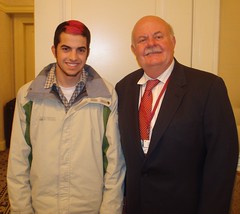 Mike Paradis attended yesterday's Kolbe sales in New York with his son Jason. He forwarded this photo of Jason with George Kolbe. Mike's caption: "George is thinking that he'd settle for pink".
Mike Paradis attended yesterday's Kolbe sales in New York with his son Jason. He forwarded this photo of Jason with George Kolbe. Mike's caption: "George is thinking that he'd settle for pink". DAVID FANNING NUMISMATIC LITERATURE LAUNCHES "THE BOOKSHELF"
As there is only one copy in stock for most of the items listed, it is suggested that customers may wish to download the PDF version in advance of receiving their hard copies (this is especially true for customers outside the United States). David Fanning can be reached at (614) 256-8915 or via e-mail at dfanning@columbus.rr.com.
NEW BOOK: TREASURE SHIP S.S. NEW YORK BY DAVE BOWERS
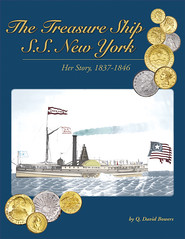 Stack’s announces the immediate release of a new book, The Treasure Ship S.S. New York: Her Story, 1837-1846, by Q. David Bowers. Combining adventure, numismatic history and lore, tragedy on the high seas, and the recovery of an undersea treasure, this book will be an absorbing “read” from front to back.
Stack’s announces the immediate release of a new book, The Treasure Ship S.S. New York: Her Story, 1837-1846, by Q. David Bowers. Combining adventure, numismatic history and lore, tragedy on the high seas, and the recovery of an undersea treasure, this book will be an absorbing “read” from front to back. The S.S. New York, launched in New York City in 1837 and earlier engaged in the coastwise trade from New York to Charleston, was important in the Gulf of Mexico some years later. In 1846 it was an important passenger and freight ship connecting New Orleans with Galveston, the latter being the largest city in the newly formed (1845) state of Texas. On one fateful day in September the ship with crew, passengers, and silver and gold coins aboard left Galveston on what was supposed to be a routine trip to New Orleans. In the days before accurate weather predictions, there seemed to be no cause for alarm.
As the ship headed out of port and into the Gulf, rain and wind increased, surely to pass quickly it was thought. That did not happen. The intensity increased, and soon the ship was in the grips of a full-fledged hurricane. The crewmen and others struggled bravely, but to no avail, and the ship went down with a loss of several dozen lives and all of the treasure.
Fast forward to modern times, and a group of treasure seekers operating out of a port in Louisiana, styling themselves as the Gentlemen of Fortune, came upon the long lost wreck. The ship’s bell was brought to the surface, giving positive identification. Legal and technical challenges had to be addressed. In the meantime, explorations continued.
By 2008, several thousand silver coins and hundreds of gold coins, up to and including 1846, had been found. Among these were some of the finest known examples of quarter eagles and half eagles from the southern mints of Charlotte, Dahlonega, and New Orleans.
Dave Bowers writes from first-hand experience, having gone out with the Gentlemen of Fortune to the wreck site to watch part of the recovery. In time, Stack’s auctioned the more important pieces. The author gives you a “you are there” experience—in New Orleans and in Galveston in 1846, and aboard the ship.
The book, fully illustrated and quality hardbound, comprises 94 pages and lists for $29.95 plus shipping handling. However (and for a limited time only), we offer you free shipping if you mention the code SSNYFREE. To order, visit our Website at www.stacks.com, or call us toll-free at 1-866-811-1804.
The first coin is a beauty, an AU 1836 quarter eagle. The U.S. quarter eagle, half eagle, and eagle coins are indeed a treasure. The one private gold coin found in the wreck is an 1834 $5 Bechtler. Next up is six pages of foreign gold coins, attesting to the wide use of foreign coins.
It's a relatively short book, but a great read and something I would encourage to be marketed and distributed both in numismatic circles and beyond. -Editor
NEW BOOK: STATE & FEDERAL COPPER AND BRASS COINAGE OF MEXICO
Ralf W. Böpple writes:The announcement and details can be found on his homepage donbailey-mexico.com
I have just ordered the book and haven't been able to take a look at it yet, but as a specialized study on a largely overlooked part of Mexican numismatics, it is a first on the topic and definitely an entry for the bibliography on the NBS homepage!
This is the first extensive effort to update the numismatic and pricing information in over thirty years. The book has eighty- four pages, with Images of 52 different coin types plus several varieties and tokens are shown. It is published on 28-pound paper, spiral bound, letter size with heavy Plastic covers.
The over all history of this interesting period of Mexico’s financial history is covered in an overview of all coins and a separate history for each entity and there is a footnote for each with historical notes and information.
“State Coppers” has been published by the Don Bailey Institute For Mexican Numismatic Research, and was compiled with the assistance of seventeen contributors, with a special credit to Ben Nibert, McAllen, Texas for sharing his vast numismatic knowledge, and also to Cory Frampton and Max Keech for sharing their choicest examples from their collections for illustrations in the book and for other efforts to make this what it is.
The pricing for this publication is $30.00 plus $5.00 shipping. Quantity discount is available. Book request and any other questions can be directed to Don Bailey
WHITMAN PUBLISHING'S LATEST TITLES
Coins: Questions & Answers by Clifford Mishler, 5th Edition, 2008, 345 pages. $9.95. Deceptively packaged as a little “pocketbook” about 4 x 7 inches (10.5 x 17.5 cm), this volume competes directly with Alan Herbert’s Coin Clinic - 1001 Frequently Asked Questions.
A Guide Book of Peace Dollars by Roger W. Burdette with Barry Lovvorn (Valuations editor, :Lawrence R. Stack), 2008, 277 pages, $19.95. The first half (176 pages) tells the full story, replete with illustrations recovered from Mint archives and other sources. The second half is the year-by-year price guide, with linear matrices of prices and certified populations, both by grade

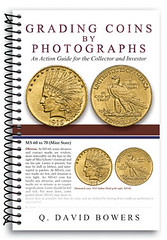
Cherrypickers’ Guide to Rare Die Varieties of United States Coins Fifth Edition, Volume 1: Half Cents to Jefferson Nickels, by Bill Fivaz and J.T. Stanton, 2009, 365 pages, $39.95. The hybrid binding, spiral protected by hardcover, makes this a tool for the bourse floor.
Grading Coins by Photographs: An Action Guide for the Collector and Investor by Q. David Bowers, 2008, 360 pages, $19.95. The importance of grading is hard to argue.
United States Pattern Coins, 10th Edition by J. Hewitt Judd, M.D., edited by Q. David Bowers, Research Associate Saul Teichman, 2009, 341 pages, $39.95. For most of us, this lovely and affordable book must stand in for the Seated Cent, the Amazonian Patterns, the Schoolgirl, and the Martha Washington Dollar of 1999 that we will never own.
Collecting Ancient Greek Coins: A Guided Tour Featuring 25 Significant Types by Paul Rynearson, 2009, 256 page, $29.95. Ancients may be coming of age in America. This book is not for beginners. An experienced numismatist seeking a new frontier, having profited from hard-won knowledge about several other areas – U. S. Type, Conders, or National Bank Notes, Inaugural Medals, etc., etc. – will find Dr. Rynearson’s work helpful in making a lateral transfer.
NEW BOOK: A GUIDE BOOK OF PEACE DOLLARS BY ROGER BURDETTE
This week I got my hands on a copy of Roger Burdette's new book from Whitman Publishing, A Guide Book of Peace Dollars. I'd been waiting for some time. Since I see Roger regularly I was aware of the project, and had the privilege of reviewing a set of page proofs a few months ago. It's great to see the project come to fruition.Correct me if I'm wrong, but I believe this is the first book devoted solely to the U.S. Peace Dollar. For years the coin has been a space filler in books covering both Morgan and Peace Dollars. As Roger's research reveals, there is a marvelous story behind the creation of the coin, with plenty of details of interest to both casual collectors and advanced numismatists. The entire first half of the book is devoted to the background and history of the coin and the men who made it a reality.
Roger's book delves into many facets of the coin's creation, from ideas put forth in the American Numismatic Association's journal The Numismatist to the Commission of Fine Arts, the design competition, De Francisci's designs and models, the striking of the coins, proofs and specimens, hoards, etc.
I found the story of the "broken sword" very interesting. The New York Herald published an editorial criticizing the inclusion of a "broken sword" symbol in the design. The editorial unleashed an avalanche of letters in opposition to the design, which had already been approved by all parties involved. The political fallout led to late stage changes in the design.
Another highlight of the book that many have been looking forward to is the section on the fabled 1964-D Peace Dollar. Roger recounts the details of the creation of the coins attempts to solve the mystery of whether any genuine specimens survive. 45 million of the coins had been authorized by Congress; about 322,000 were struck before the orders were given to halt production and destroy all of the struck coins.
While looking up other things I happened to come across the following image of a 1964-D Peace Dollar. No, it's not an original. But could one or more originals be lurking out there somewhere? Read all about it in Roger's book!
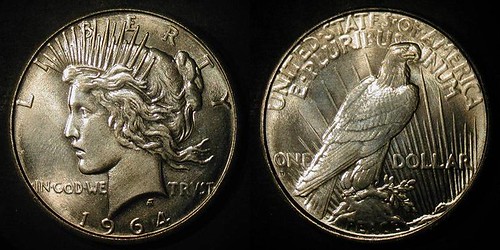
I have few criticisms of the book, all minor. First, I think the book's title should be A Guide Book of United States Peace Dollars. Although I would prefer to see more footnotes and endnotes, I can see the point of not using them extensively since so many fact sources were already documented in the corresponding sections of Roger's Renaissance of American Coinage 1916-1921. The 1964-D chapter, which contains a great deal of new information not documented elsewhere is fortunately well annotated.
My last criticism has nothing to do with the book, but instead its cover. It's soft. I guess I'm getting picky in my old age, but I greatly prefer a hardbound book. Like my brother-in-law who tells us our small dog is "a waste of a dog", I feel that a softcovered book is (almost) a waste of a book. The copy I've had for less than a week is already dinged at the cover. Hard covers serve a real purpose - to protect the book from such indignities.
Anyway, congratulations to Roger and Whitman for a great book on a deserving coin.
THE BOOK BAZARRE
DICK JOHNSON CALLS FOR THE REPLACEMENT OF THE ANA'S LOGO
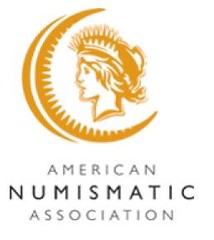 Resolved: In the year 2009 the ANA will replace the atrocious logo it is currently using.
Resolved: In the year 2009 the ANA will replace the atrocious logo it is currently using. Would you believe a numismatic organization chose the worst possible logo as a symbol of an organization of people who collect glyptic items with a graphic design? That is stupidity raised to a factor of five.
Glyptic objects are coins, medals and tokens, it is the raised relief design on these numismatic items. Engravers and numismatists call it "relief," a sculptor creating a sculptural model as a pattern for a coin or medal calls it "bas-relief" (the "s" is silent -- it is pronounced baa-relief). [If you are interested I listed the six different kinds of relief found on numismatic items previously in E-Sylum -- vol 10, no 37, art 10 for September 16, 2007].
This present logo -- the lady in a crescent -- is a holdover from the tainted administration of executive director Chris Cipoletti. It was a Colorado Springs ad agency who came up with this inappropriate, misguided, inapt design which an unknowing Cipoletti installed in 2003 replacing the Students Lamp of Knowledge in use for decades prior.
I wrote a long editorial castigating this design which was published in Coin World July 29, 2003. Everything I said in that editorial still holds true. The new design missed capturing the essence of numismatics. Much of the charm of numismatic items is the detail they display, I said.
Not only is detail excoriated from the new design, it appears to thrust fuzzy outline and crude figures, the furthest thing from what's on coins and medals, to the forefront. The five factors of stupidity: overlooking the three dimensions on coins, medals, tokens, the lack of detail, replaced with a fuzzy graphic.
On March 22, 2008 I wrote the new ANA Executive Director Larry Shepherd, pleading to replace the existing logo with a more appropriate one. I neither received a reply nor have I heard of any movement in this direction.
I pointed out a new logo needs to be created by a medallic sculptor, in bas-relief. Further, a graphic design -- as for printing on stationery, in The Numismatist, and for other logo use -- can be made from a three-dimensional model. But the opposite does not necessarily hold true. You cannot easily make a glyptic relief from a graphic design. Create the 3-D design first.
The added benefit of a medallic bas-relief it becomes the pattern for award medals the organization issues.
Larry Shepherd, please purge one of the last vestiges of the Cipoletti era with a new logo before the new year is over.
QUERY: NUMISMATIC CHRONICLE REPRINTS
John Isles writes:Current offerings on Amazon.com are the volume (number not given) for 1872, "V17" (for 1897), Volume VII (year not given), Volume XIII (1913), and Volume XIV (year not given). I'm guessing that VII is for 1907 and XIV is for 1914, but the volume numbers for this journal aren't unique: there were several issue series of the original volumes, in each of which for some reason (I suppose) the numbering of volumes or issues was begun afresh from 1.
I'm wondering whether to buy these to help to fill gaps in my collection. If anybody has seen these reprints, I'd be most interested in any comments on the quality of reproduction.
ON THE UBIQUITY OF THE EURO
Regarding our item on the tenth anniversary of the Euro, Joe Boling writes:SOURCES ON TWO MOON, FRASER'S INDIAN HEAD NICKEL MODEL
Regarding Ginger Rapsus' query about one of the models for James Earle Fraser's Indian Head/Buffalo nickel, Roger Burdette writes:MORE ON JOSEPH CLOUD OF THE PHILADELPHIA MINT
I had recently received the text of this clipping from an Eckfeldt descendent:
The Eckfeldts set up a remarkable record for their connection with the U.S. Mint in Philadelphia. That association spanned 136 years and without a break of a single day.
At Ambler resides Jacob B. Eckfeldt, aged 92, who got a job in the mint on April 15, 1865, the day President Lincoln died. President Arthur elevated him to the position of assayer in 1881, a position he occupied until his resignation in 1930, a service of 65 years.
It was Granfather Adam Eckfeldt who began the money-coining business for that family in the original Mint on Seventh Street. He was employed by illustrious Dr. David Rittenhouse, whom President Washington selected as first Director of the Mint.
Eckfeldt operated the screw press in 1794 when the Whisky Rebellion was foremost news of the day. That pioneer Eckfeldt became Coiner and Die Forger, the former position by appointment of President Madison, and he continued in the place down to 1839.
During that time, the US Mint occupied its once notable home at Chestnut and Juniper streets. Eckfeldt selected that site. His city home was at Vine and Juniper, but it was he who bought the now famed Eckfeldt farm in Delaware County with it still standing farmhouse.
Adam's son, Jacob, got his place in the U.S. Mint when Jackson was President back in 1832 and was still there until President Grant occupied the White House in 1872. For seven years he and his still living son, Jacob, were both in the Mint.
This family record has no parallel in the long span of years during which it served in the production of American coins."
The Bala Golf Club is near City Line Road and the Pennsylvania Rail line. I have been unable to confirm this was the Cloud/Eckfeldt farm. St. Joseph’s University is nearby but I have been unable to locate an astronomical observatory. This is where my research ended three weeks ago. I would be happy to hear from any E-Sylum reader who con confirm the location of the Cloud/Eckfeldt farm.
I have been corresponding with two sisters-in-law who are interested in Eckfeldt genealogy. Through them I have discovered an interesting family connection.
William Ewing DuBois married Susanna Eckfeldt in 1841 connecting the DuBois and Eckfeldt families. One of my correspondents, a descendent of the DuBois line, married a descendent of the Eckfledt line in 1969. This has no numismatic importance but is a small payoff for hours of genealogical research.
BARACK OBAMA MEDAL BY DANIEL ALTSHULER
George included a link to a medal by Daniel Altshuler of DIA Sculpture Studios, Gloucester, MA. -Editor
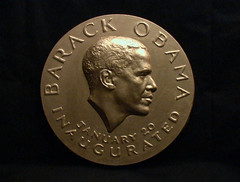
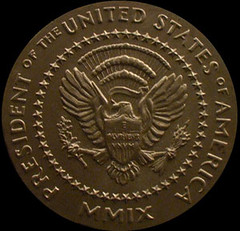
For more information on the Daniel Altshuler medal, see: Presidential Inaugural Medal of Barack Obama (www.altshulersculpture.com)
NUMISMATIC TRUTH SQUAD
Little bugs us numismatists more than misstatements in the general press or worse, in books. Jared Dawber writes:ARTICLE PROFILES INDIAN BOY'S HUGE NUMISMATIC COLLECTION
The first rendezvous with antique coins for this 15-year-old numismatist came at an early age, when he received some coins from his grandfather.
Drawn by their rustic old-world charm Prasad was initiated into the hobby, which has now become a passion for him. Over the time, he has gathered coins and even some currency notes from different sources across India.
"I have gathered these coins from different places. Some from exhibitions, some from mints, I had to become a member of the mints to get the coins from there. Then some people also gifted me coins and I even got coins from people outside my state," said Devi Prasad Maharaj, coin collector.
Prasad's collection of coins and currency notes is quite varied and currencies from different countries adorn his prized treasure.
Coins dating back to 18th century, Elizabethan era, gold coins which were in use during the reign of ancient and medieval Indian rulers, pennies, and other unique coins with imprints of animals and gods and much more, form a part of his collection.
To read the complete article, see: Indian boy sitting on a treasure trove of rare coins (http://www.timesnow.tv/Newsdtls.aspx?NewsID=25056)
DOGS, CATS AND NUMISMATIC LITERATURE
Phil Iversen writes:Larry Gaye writes:
NEW "HARD TIMES" TOKENS FROM COIN DESIGNER DANIEL CARR
Regarding the topical John Law "bankruptcy" medals discussed last week, An E-Sylum reader writes:Who needs Morgans and their VAMS, and Franklins and Full Bell Lines when there are interesting things like this? I'd love to buy some of R.W. Julian's satirical medals from the 1970s (I learned of them in an issue of the MCA Advisory a few years ago).
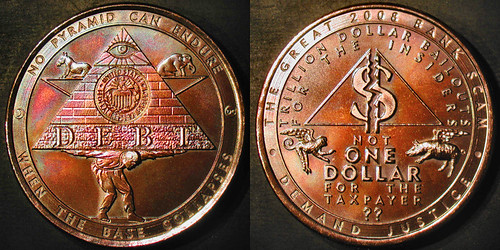
Anyway, the design and execution of the piece are very true to the prototype 1837 series of Hard Times Tokens. Great job! I would encourage other designers to try their hand at producing original tokens reflecting the times. Start a fad! I'd like to see original, contemporary products like these being promoted for sale widely. I'll bet the Home Shopping Network would find a lot of buyers in people disgusted with the current state of affairs. -Editor
For more information, or to order, see: Hard Times Tokens (http://www.dc-coin.com/index.asp?PageAction=VIEWCATS&Category=11)
THE BOOK BAZARRE
THE GREAT DENVER MINT ROBBERY OF 1922
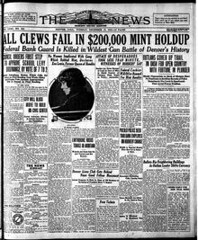 Six days before Christmas 1922, the Rocky's page 1 lead story had all the elements of a best-seller - the robbery of $200,000 from the U.S. Mint, a shootout and getaway in downtown Denver, and the alluring notion that the "queen" of a bandit gang might somehow be involved.
Six days before Christmas 1922, the Rocky's page 1 lead story had all the elements of a best-seller - the robbery of $200,000 from the U.S. Mint, a shootout and getaway in downtown Denver, and the alluring notion that the "queen" of a bandit gang might somehow be involved.That 63-word first paragraph was only the beginning of breathless coverage that would continue for days. The paper printed eight stories the first day after the robbery.
Four masked "desperadoes" in a black touring car, with curtains drawn, pulled in front of the West Colfax Avenue entrance to the mint alongside a Federal Reserve bank truck.
" 'I heard a shot, then several. Then the general alarm going in the mint,' superintendent Robert Grant told reporters after. 'Every man picked up a rifle and rushed to the door.' "
But Linton was shot, dying, and the robbers had grabbed 50 packages of $5 bills that the guards had been transferring into the truck.
Eighteen days later, the shot-up getaway car was found in a Denver garage. Sitting inside was the frozen body of one robber injured in the shootout. Part of the money, $80,000, eventually was recovered in Minnesota. Then, in 1934, Denver police announced that five men and two women had been linked to the robbery, but no names were released. Police said all of the suspects were either dead or in prison for other crimes.
No one was ever charged for the heist.
To read the complete article, see: December 19, 1922: The great mint robbery (http://www.rockymountainnews.com/news/2009/jan/04/the-rocky-150-years-the-great-mint-robbery/)
JOHN LENNON'S RETURNED MEDAL FOUND IN ROYAL VAULT
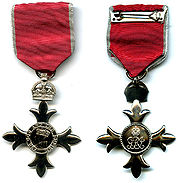 The MBE medal that former Beatle John Lennon famously rejected has been found in a vault at St James' Palace.
The MBE medal that former Beatle John Lennon famously rejected has been found in a vault at St James' Palace.All four Beatles were awarded the honour in the Queen's Birthday Honours in 1965 for their services to music. But Lennon returned his in 1969 in protest against the Vietnam war.
The medal was discovered in it original presentation case – which bears the name John Winston Lennon – alongside a personal letter from Lennon to the Queen.
In the letter, Lennon wrote: "Your Majesty, I am returning my MBE as a protest against Britain's involvement in the Nigeria-Biafra thing, against our support of America in Vietnam and against 'Cold Turkey' slipping down the charts. With Love, John Lennon."
Beatles fans have called for the medal, which is thought to have lain untouched at the Chancery Department of the Royal Household for years, to go on public display.
To read the complete article, see:
(http://www.gigwise.com/news/48522/Beatle-John-Lennons-MBE-Found-In-Royal-Vault)
From Wikipedia:
Knight Grand Cross (GBE) or Dame Grand Cross (GBE)
Knight Commander (KBE) or Dame Commander (DBE)
Commander (CBE)
Officer (OBE)
Member (MBE)
Only the two highest ranks entail admission into knighthood, an honour allowing the recipient to use the title 'Sir' (male) or 'Dame' (female) before their first name.
Order of the British Empire (http://en.wikipedia.org/wiki/Order_of_the_British_Empire)
ARTICLE HIGHLIGHTS ROBERT LEE BURTON'S EASTERN SHORE PICKING AND CANNERY TOKENS
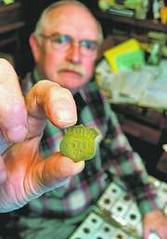 What started out as a hobby became a mission, as the late Robert Lee Burton of Cambridge discovered when he sought out tokens -- those paper, metal, rubber, fiber and even leather substitutes for money used by Shore farmers and canning houses decades ago.
What started out as a hobby became a mission, as the late Robert Lee Burton of Cambridge discovered when he sought out tokens -- those paper, metal, rubber, fiber and even leather substitutes for money used by Shore farmers and canning houses decades ago. For years, the former state employee traveled the Shore digging his way through antique shops, barns, sheds, buckets -- and even sifting through dirt -- looking for examples of lost or forgotten tokens. They came in a variety of sizes and styles -- circular, square and badge-shaped, diamonds and multi-sided and were given to workers for picking strawberry, peaches, tomatoes and for skinning tomatoes, shucking oysters and picking crabs.
At the end of the day or week, a worker redeemed tokens for cash or even credit at the company store. Introduced in the 1860s, their use had vanished by the 1950s.
That hobby came about while Burton was working on a book on area canneries.
"There was over a thousand different canneries that operated on the Eastern Shore, with 246 operating at one time," said George Chevalier, president of the Wicomico County Historical Society and a founder of the Maryland Token and Medal Society in 1976. Through the society, he met Burton.
"While Mr. Burton was interviewing the families who owned and operated these canning factories for his book, which he started in 1981, and a lot of them showed him tokens and many were given to him."
Burton authored "Canneries of the Eastern Shore," the Bible of token collecting published in a limited edition in 1986. It is already considered a rare Maryland book and is itself collected by the token collectors.
"There were only 1,500 printed, but there was a fire and 300 were destroyed at the printers in Centerville," Chevallier said.
Burton, who had a reputation among collectors for being tight fisted, never paid more than $40 for a token, his friend said.
"But above all, he was the dean of token collectors," Chevallier said.
To read the complete article, see Tokens hold a piece of history (http://www.delmarvanow.com/article/20090111/LIFESTYLE/901110320)
FLORIDA SHELL STORE LAUNCHES MONEY MUSEUM DISPLAY
An E-Sylum reader writes:The Shell Factory has launched a new exhibit within its shops, sure to be a favorite with coin enthusiasts. The Money Museum is a free exhibit that features coins and notes and “oddities in mediums” from different eras and from around the world.
There’s Greek coins from 356 to 323 B.C., bronze coins from the Roman Empire circa 253 A.D., notes from each of the first 13 colonies, original Confederate bills, specially minted World War II notes and more.
“The exhibit is incredible,” said Kathy VanderJaqt, retail manager. “The history of it is fascinating.”
One of her favorite parts of the exhibit is a display featuring a Mongolian bridal vest, a vest sewn full of coins.
“Brides wore these in Mongolia and Afghanistan as a dowry,” she said.
She also noted a detailed display of the famous El Cazador sunken treasure. Also called “The Hunter,” the ship is famous in the coin world, noted as “the shipwreck that changed the world.”
In other areas, the exhibit features Mayanmar rupees, yen from China, Military Payment Certificates from the Vietnam War and even “Giant Spear Money” from Africa, used before traditional monies for currency and trade.
“We’re going to expand the exhibit in the future,” said VanderJaqt. “Everything is for sale in the exhibit except for some of the donated memorabilia.”
Many guests are already commenting on the wide array of eras and their tender at the new exhibit.
“Of all our new attractions, The Money Museum has been the most surprising to me,” said the Shell Factory’s Pamela J. Cronin. “The historical aspects of the coins, notes and bonds is extremely interesting and we are astonished at the level of interest from the public.”
A display of sea-salvaged coins such as those in the store's exhibit could be a great way to entertain and enlighten people waiting for the Pirates of the Caribbean. How about a set of gold Celestons for Tomorrowland? Or coins and medals of Queens and Princesses for Cinderella's castle? -Editor
To read the complete article, see: Money Museum exhibit launches at Shell Factory (www.northfortmyersneighbor.com/news/articles.asp?articleID=4953)
THE NEW YORK TIMES ON ELECTRONIC BOOKS
 Could book lovers finally be willing to switch from paper to pixels?
Could book lovers finally be willing to switch from paper to pixels?For a decade, consumers mostly ignored electronic book devices, which were often hard to use and offered few popular items to read. But this year, in part because of the popularity of Amazon.com’s wireless Kindle device, the e-book has started to take hold.
The $359 Kindle, which is slim, white and about the size of a trade paperback, was introduced a year ago. Although Amazon will not disclose sales figures, the Kindle has at least lived up to its name by creating broad interest in electronic books. Now it is out of stock and unavailable until February. Analysts credit Oprah Winfrey, who praised the Kindle on her show in October, and blame Amazon for poor holiday planning.
The shortage is providing an opening for Sony, which embarked on an intense publicity campaign for its Reader device during the gift-buying season. The stepped-up competition may represent a coming of age for the entire idea of reading longer texts on a portable digital device.
“The perception is that e-books have been around for 10 years and haven’t done anything,” said Steve Haber, president of Sony’s digital reading division. “But it’s happening now. This is really starting to take off.”
Sony’s efforts have been overshadowed by Amazon’s. But this month it began a promotional blitz in airports, train stations and bookstores, with the ambitious goal of personally demonstrating the Reader to two million people by the end of the year.
The company’s latest model, the Reader 700, is a $400 device with a reading light and a touch screen that allows users to annotate what they are reading. Mr. Haber said Sony’s sales had tripled this holiday season over last, in part because the device is now available in the Target, Borders and Sam’s Club chains. He said Sony had sold more than 300,000 devices since the debut of the original Reader in 2006.
To read the complete article, see: Turning Page, E-Books Start to Take Hold (http://www.nytimes.com/2008/12/24/technology/24kindle.html?
_r=1&ei=5070&emc=eta1)
ARTICLE REVIEWS NEW YORK FEDERAL RESERVE BANK TOUR
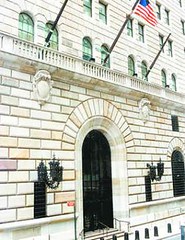 The economic crisis was palpable throughout Manhattan's financial district, yet the atmosphere inside the Federal Reserve Bank of New York was eerily serene, almost like a church.
The economic crisis was palpable throughout Manhattan's financial district, yet the atmosphere inside the Federal Reserve Bank of New York was eerily serene, almost like a church. It was fitting, for money is worshiped at "the Fed," as the central bank is known, and a visit to the nation's central bank feels like a trip to capitalism's cathedral. Instead of the bodies of saints, the bank's catacombs hold about $180 billion in gold bars - more gold than is stowed in Fort Knox, and almost one-quarter of the world's supply.
As New York tourist destinations go, the historic landmark on Liberty Street attracts a fraction of the visitors who flock to the city's more famous spots.
The bank's free 30-minute guided tour won't give you a complete grasp of the nuances of reserve requirements and the difference between real and nominal gross domestic product. Yet you will leave knowing a lot more about money than when you walked in, and some of it will be more enjoyable than a college economics class.
The first thing you come across is what looks like an unguarded gold bar, slowly spinning with the invitation, "Help yourself!"
But the bar turns out to be a hologram, your hand passing through it like fog. Although the tour is largely humorless and strict (you're instructed not to take pictures or notes in the massive subterranean gold vault), the displays in the lobby - a stunning foyer adorned with designer Samuel Yellin's 200 tons of ornate wrought ironwork - are surprisingly fun, even as they're informative.
Used banknotes are no longer burned (it's not green to send up green in smoke) but shredded, and there's $48 million in minced $100 bills in one display, part of the $105 million in paper currency cut up daily.
Not far away, an exhibit about counterfeiting presents some really good fakes; only with an oversized magnifying glass that slides over both the real and the ersatz bills (along with what-to-look-for pointers in the exhibit) can you spot the impostor $5, $10 and $20 bills.
Hundreds of rare coins and currency to illustrate the history of money, grouped by era and region, are on loan to the bank from the American Numismatic Society. The highlights include a shekel from 109 B.C., and the most valuable coin ever sold, a U.S. 1933 Double Eagle that fetched nearly $8 million in a recent auction.
To read the complete article, see: A cathedral of capitalism (http://www.philly.com/philly/travel/20090111_A_cathedral_of_capitalism.html)
PRINTER'S PROOF OF RARE 1927 "LONDON TO LONDON" STAMP FOUND
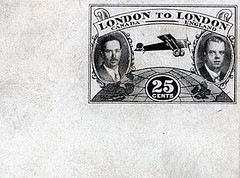 This is a story about a failed first flight, a vanished shipment of airmail, a midnight robbery, and a `stamp' – lost to the world for 81 years – that fetched $10,000 last month in a Toronto auction.
This is a story about a failed first flight, a vanished shipment of airmail, a midnight robbery, and a `stamp' – lost to the world for 81 years – that fetched $10,000 last month in a Toronto auction.The story begins in the summer of 1927.
Charles Lindbergh has just completed the first solo flight from New York to Paris.
A series of distance-stretching transatlantic adventures ensue, some successful, others not.
Among those sponsoring the expansion in aviation is a small London, Ont., brewery offering $25,000 to fly from London, Ont., to London, England.
The flight of The Sir John Carling (named for that local brewery) takes off in late summer, piloted by a Canadian veteran of World War I, Capt. Terrance Tully, and his navigator, James Medcalf.
Laden with a light shipment of commemorative airmail and enough fuel to cross the North Atlantic, the fixed-wing six-seat aircraft takes off into bad weather on a perilous journey into history.
Waiting for The Sir John Carling in England: A tickertape parade and the $25,000 reward.
But Tully and Medcalf never make it. They disappear into a heavy fog off the coast of Newfoundland. The pilots, the plane and the airmail are never seen again.
Eighty-one years later, a relic of the event, the only known printer's proof of the commemorative stamp – the same stamps on the mail onboard the flight – is discovered in the sock drawer of a Bay St. banker.
It was a gift, given to the banker by his father who had inherited it years earlier from a friend who had gotten it directly from the printer who had cast it on paper in London, Ont., or so the story goes.
It is a proof, a test stamp made by the printer before printing some 100 of the semi-official 25 cent stamps for the flight. Those stamps – made from blue and yellow die cast on white paper – show the framed portraits of Tully and Medcalf on either side of the globe along with an image of The Sir John Carling flying the Atlantic. They are worth a lot of money.
"Only nine of the stamps are known to have survived," Talman says. Most of them went down with the plane, the others survived by fluke or by mischief.
Four of the stamps are thought to have been given to Tully's wife before the plane took off. Folklore tells of a break-in the night of the plane crash, in which the stamps were stolen while the soon-to-be widow was out for supper.
No one knows what happened to those stamps, he says. But of the nine that have surfaced in the decades since the crash, some are in private hands, others are in the British Library's stamp collection while a mint copy of one of the semi-official labels is on display in the Smithsonian.
To read the complete article, see: 'Stamp' found in sock drawer reopens 1927 intrigue (http://www.thestar.com/News/article/568999)
ARTICLE: THE GREAT DUPONT COIN HEIST
In short order, the thieves tied up Miren and Willis and dumped $1.5 million worth of ducats, rubles, and the rarest of the rare gold and silver coins into several duPont suitcases. They then took off in Miren’s new red Cadillac convertible. About 20 minutes later, the butler freed himself and called police.
Because the robbers had managed to avoid the sophisticated alarm system, investigators at the scene suspected the duPonts were victims of an elite group of criminals who’d staged a recent series of waterborne invasions at several exclusive Florida estates.
But it was not long before Willis offered a more prosaic explanation: “We hadn’t turned the system on,” he said glumly. The thieves had simply scaled the walls of the compound and made their way inside through an unlocked patio door. “That door never had latched properly,” Willis added.
Gone were 7,000 coins including the famous 1866 “no motto” set, the prized Linderman and Cohen 1804 silver dollars, and a number of gold coins struck by private and territorial mints. One of the more notable specimens of the latter was a token from the Colonial days, the “Brasher doubloon” of 1787.
There were 257 coins belonging to the Mikhailovich collection. Originally the property of a cousin of Czar Nicholas II, it had disappeared from Russia under mysterious circumstances and become to coin collectors what the Maltese Falcon was to Humphrey Bogart. Willis had managed to acquire the collection during the 1950s and had begun an incremental transfer to the Smithsonian Institution. The total value of the theft amounted to about $8.5 million in present-day dollars, and none of the coins were insured.
To read the complete article, see: The Great Coin Heist by Les Standiford (http://mench113.blog.friendster.com/2008/11/the-great-coin-heist-by-les-standiford/)
ANOTHER ALTERNATIVE CURRENCY: SALT SPRING DOLLARS
My research has not progressed to the point where I can say anything much more coherent about Salt Spring Dollars than the Salt Spring Island Monetary Foundation has to say for itself at http://www.saltspringdollars.com/.
It appears that the currency was somewhat more oriented towards promoting this island in British Columbia in the gulf between Vancouver Island and the U.S., rather than the experimentation with local monetary policy some groups focus on.
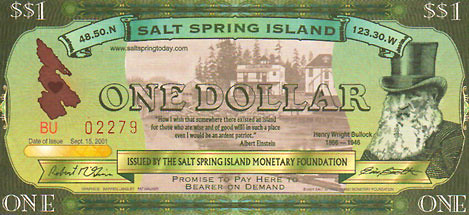
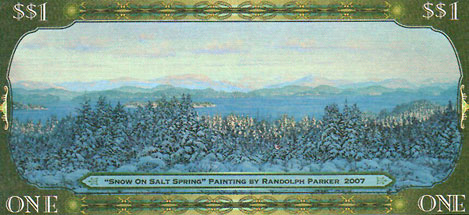
I've contacted at least one of the local groups and gotten the sense that collectors and outside interest are both somewhat disdained. Despite this, it appears the currency is actively used on the island and not just something to sell to the collectors.
See also http://numismondo.com/pm/ssi/ for somebody who has actually assigned catalog numbers.....
The Monetary Foundation is happy to let you know that the Bank of Canada saw fit to mention them in Appendix B: Alternative Money in A History of the Canadian Dollar. See http://www.bankofcanada.ca/en/dollar_book/
Two questions arose – would it be possible to establish a local currency for Salt Spring, and if so, how could it benefit the community?
Having identified these problems, it was decided any solutions must address all of these concerns. Several brainstorming sessions later, an idea surfaced that provided an answer directly and indirectly, to all of the major problems. It was suggested that if our currency had a two year expiry date, any bills that had not been redeemed by the expiry date (e.g. collected, left the island, lost, etc.) would represent a "profit."
By creating a profit, to cover costs, it would be possible to have the currency go into circulation through a one-to-one exchange with the Canadian dollar. This meant it could be backed 100% by the Canadian dollar. To our knowledge this had never been done by any local currency, anywhere in the world.
On July 17th, 2001, the SS IMF was registered with the Province of British Columbia. It's mission statement is as follows: "The purposes of the Society are to design, issue and maintain a local currency for Salt Spring Island with the goal of raising funds for worthwhile community projects while promoting local commerce and goodwill."
Following the formation of the IMF, major institutions (Island Savings Credit Union, CIBC, Bank of Montreal, Canada Post, SSI Chamber of Commerce, etc.) on the Island were approached with the concept. With these institutions lending their support to this community initiative, it came to pass that Salt Spring Dollars are now available and accepted on Salt Spring on the same basis as the national currency. The Salt Spring Island Dollars were introduced to the Island on September 15th, 2001, at Salt Spring's largest annual gathering, the Farmer's Institute's Fall Fair.
To learn about other local currencies in North America, see: Other local currencies (http://saltspringdollars.com/about-us/other-local-currencies.html)
BRITAIN'S TAX CUT MAY CREATE NEED FOR MORE COINS
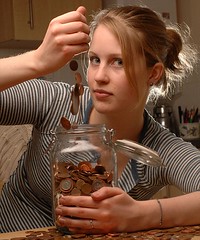 While other countries are considering abolishing their lowest denominatin coins, Great Britain is fearful they don't have enough. A tax cut in the VAT (sales tax) initiated in November may result in greater demand for one and two-pence coins.
While other countries are considering abolishing their lowest denominatin coins, Great Britain is fearful they don't have enough. A tax cut in the VAT (sales tax) initiated in November may result in greater demand for one and two-pence coins. Previously the 17.5 percent tax was often built in retail prices. Now the price is lowered with only a 15 percent tax. For example a £4.99 item, which would previously have called for just one penny in change from a £5 note, will now cost £4.88, increasing the demand for change.
All of this means that much more small change is needed when customers pay in cash. The Royal Mint is on alert for an increase in demand. 'We have been looking into this,' said a Royal Mint spokesman. 'We are monitoring the position closely. There is no sign as yet, but it may be a bit early for demand to have fed through the system.'
A recent article reveals the following data on coins currently in circulation in the UK:
• There are coins worth about £3.6 billion in circulation, of which £2, £1 and 50p pieces account for £2.5 billion, or 70 per cent.
• Smaller silver coins - 20p, 10p and 5p - account for £815 million, or 23 per cent.
• Copper coins - 2p and 1p - account for £241 million, or seven per cent.
Interestingly, Coinstar operates in Great Britain as well as North America. Coinstar machines in the UK have processed more than £500 million in change, in approximately 22 million transactions. More than two billion coins have passed through the machines.
Here is the article for more information: Coin shortage crisis looms after Darling's VAT cut (http://www.dailymail.co.uk/money/article-1111554/
Coin-shortage-crisis-looms-Darlings-VAT-cut.html)
CURSES FROM 'THE OLD LIBRARIAN'S ALMANACK'
Bill Eckberg writes:For Him That Stealeth a book from this library, let it change into a serpent in his hand and rend Him. Let Him be struck with Palsy & all his members blasted. Let him Languish in Pain, crying aloud for Mercy, & let there be no surcease to his Agony until he sink to Dissolution. Let Bookworms gnaw his Entrails in token of the Worm that dieth not, & when he goeth to his final Punishment, let the flames of Hell consume him for ever & aye.
I don’t know about you, but I’d certainly have given the book back after reading that. I didn’t know monks were supposed to get that angry!
I was intrigued and did a little online research looking for more information on the quote. It's been reprinted widely, but alas, it appears to be fiction.
It first appeared a hundred years ago, in a 1909 publication titled "Philobiblos - The Old Librarian's Almanack: A very rare pamphlet first published in New Haven Connecticut in 1773. The book purported to be a reprint, but was in fact authored by Edmund Lester Pearson (1880- 1937), a professional librarian.
There's even a book about the book, a 1979 publication by Wayne A. Wiegand, The History of a Hoax: Edmund Lester Pearson, John Cotton Dana, and 'The Old Librarian's Almanack' Pearson's book sounds like a marvelous satire on the profession. Here's another take on the book along with a couple other quotes. -Editor
Pearson's "Old Librarian" views library patrons as insufferable nuisances distracting librarians from their true vocation (personal reading), when not an actual danger to precious books they itch to steal or damage. Patrons certainly had no useful suggestions to make on what books to acquire. No librarian in 1909 would admit to sharing the "Old Librarian"s attitudes, but some of the satire could apply to bureaucracies in general.
"So far as your Authority will permit of it, exercise great Discrimination as to which Persons shall be admitted to the use of the Library. For the Treasure House of Literature is no more to be thrown open to the ravages of the unreasoning Mob, than is a fair Garden to be laid unprotected at the Mercy of a Swarm of Beasts.
"Question each Applicant closely. See that he be a Person of good Reputation, scholarly Habits, sober and courteous Demeanour. Any mere Trifler, a Person that would Dally with Books, or seek in them shallow Amusement, may be Dismiss'd without delay.
To read the complete article, see: Edmund Lester Pearson's Old Librarian's Almanack (http://www.cyberussr.com/hcunn/q-librarian.html)
FEATURED WEB SITE: HELLENIC NUMISMATIC SOCIETY
This week's Featured Web Site is the Hellenic Numismatic Society.
The journal of the Society, Nomismatika Khronika (NomKhron) has been appearing since 1972. It contains articles by Greek and foreign scholars, covering the whole range of the history of coins in the Greek World, as well as related subjects. It is now completely billingual: all articles are printed in their original language (usually Greek or English) with a full translation or detailed summary in Greek or English as required.
http://www.coins.gr/hellenum/

